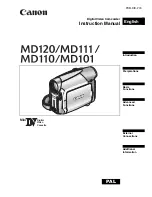
100
The “Memory Stick” is a new light and small recording media which, despite of the
size, can store greater data than a floppy disk.
The “Memory Stick” can, in addition to recording images and easily playing back
images you want to see, follow operations such as:
– Copying images into the “Memory Stick” from the tape
– Capturing images into the computer using the supplied USB cable
– Allow image deletion, protection and writing (with a print mark).
File format
Still image (JPEG)
Your camcorder compresses and records image data in JPEG (Joint Photographic
Experts Group) format. The file extension is .jpg.
Exif *Ver.2.2 JPEG compliant, DPOF compatible.
*Exif: Exif is a file format for still images, established by the Japan Electronics and
Information Technology Industries Association(JEITA). Files in this format can have
additional information such as your camcorder’s setting information at the time of
recording.
Moving picture (MPEG)
Your camcorder compresses and records picture data in MPEG (Moving Picture Expert
Group) format. The file extension is .mpg.
Typical image data file name
Still image
101-0001:
This file name appears on the screen of your camcorder.
DSC00001.JPG: This file name appears on the display of a computer.
Moving picture
MOV00001:
This file name appears on the screen of your camcorder.
MOV00001.MPG: This file name appears on the display of a computer.
To prevent from erasing images accidentally
Rear part of the “Memory Stick”
Slide the write-protect tab on the “Memory Stick” to LOCK.
The position and shape of the write-protect tab may be different depending on the
model.
Some kinds of “Memory Stick” have no write-protect tab.
Notes on the “Memory Stick”
Labeling position
Stick its label on the labeling position.
— “Memory Stick” Operations —
Using “Memory Stick” – Introduction
Terminal
Write-protect tab
Labeling position
















































